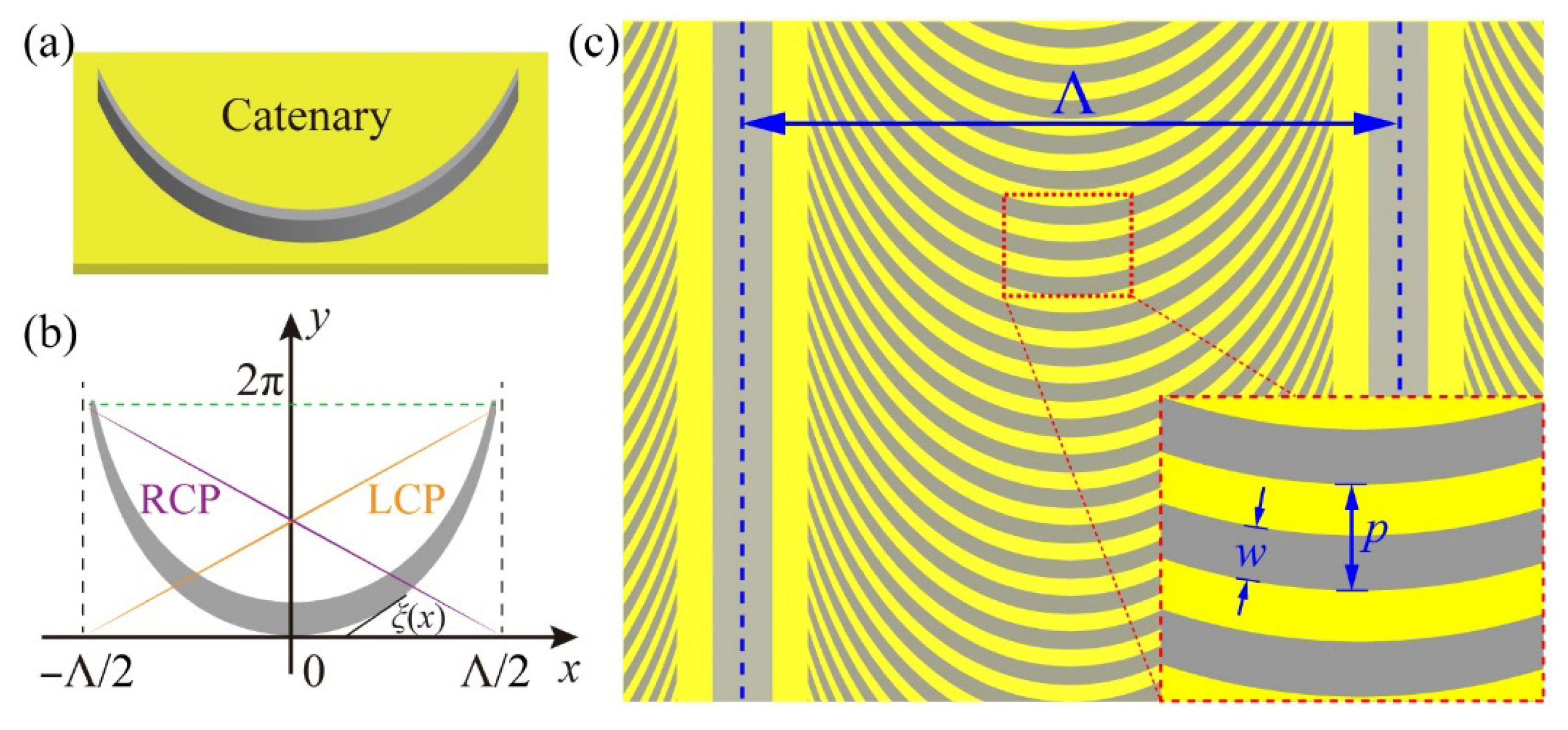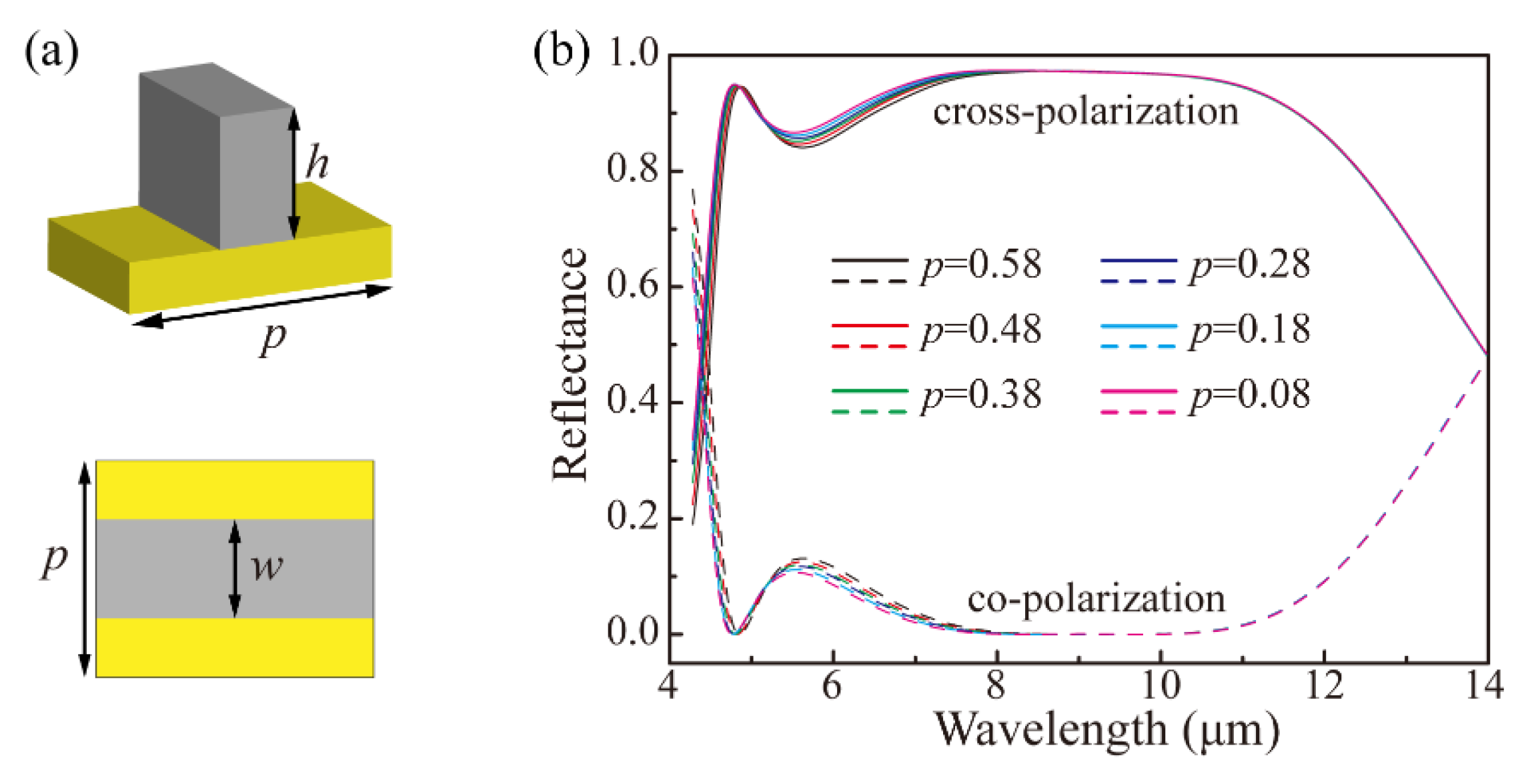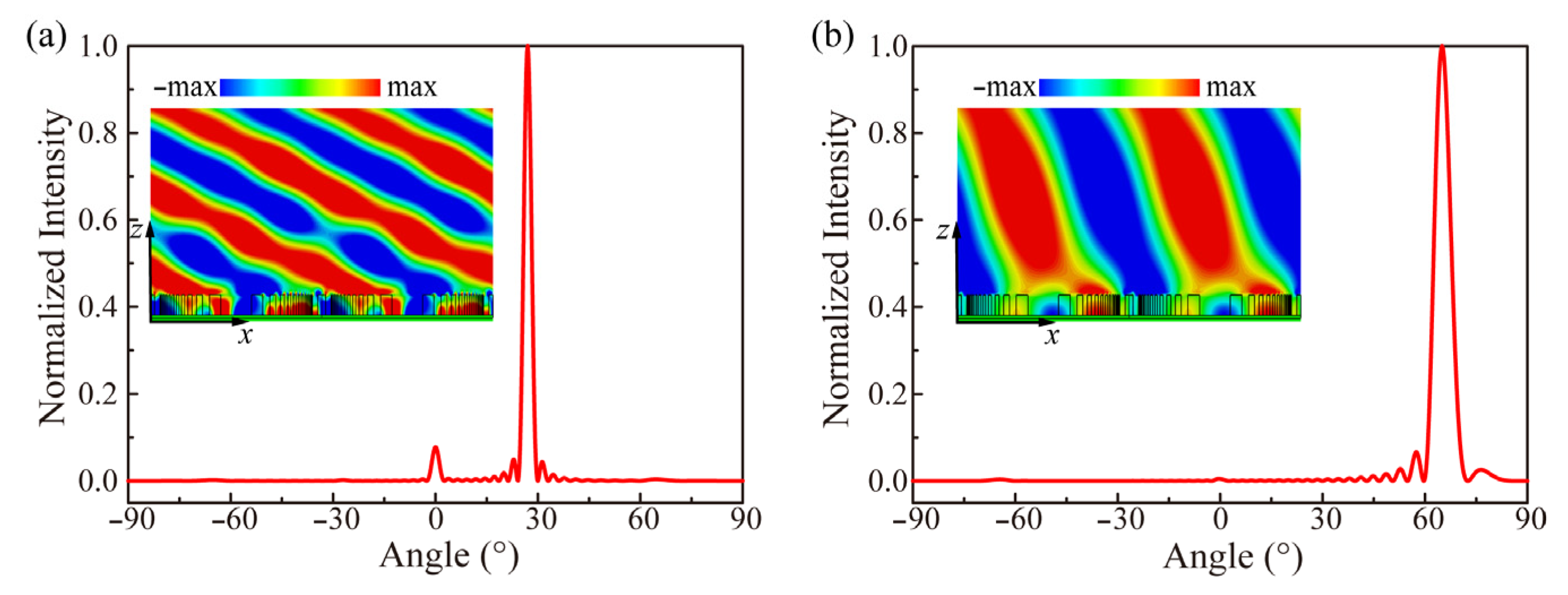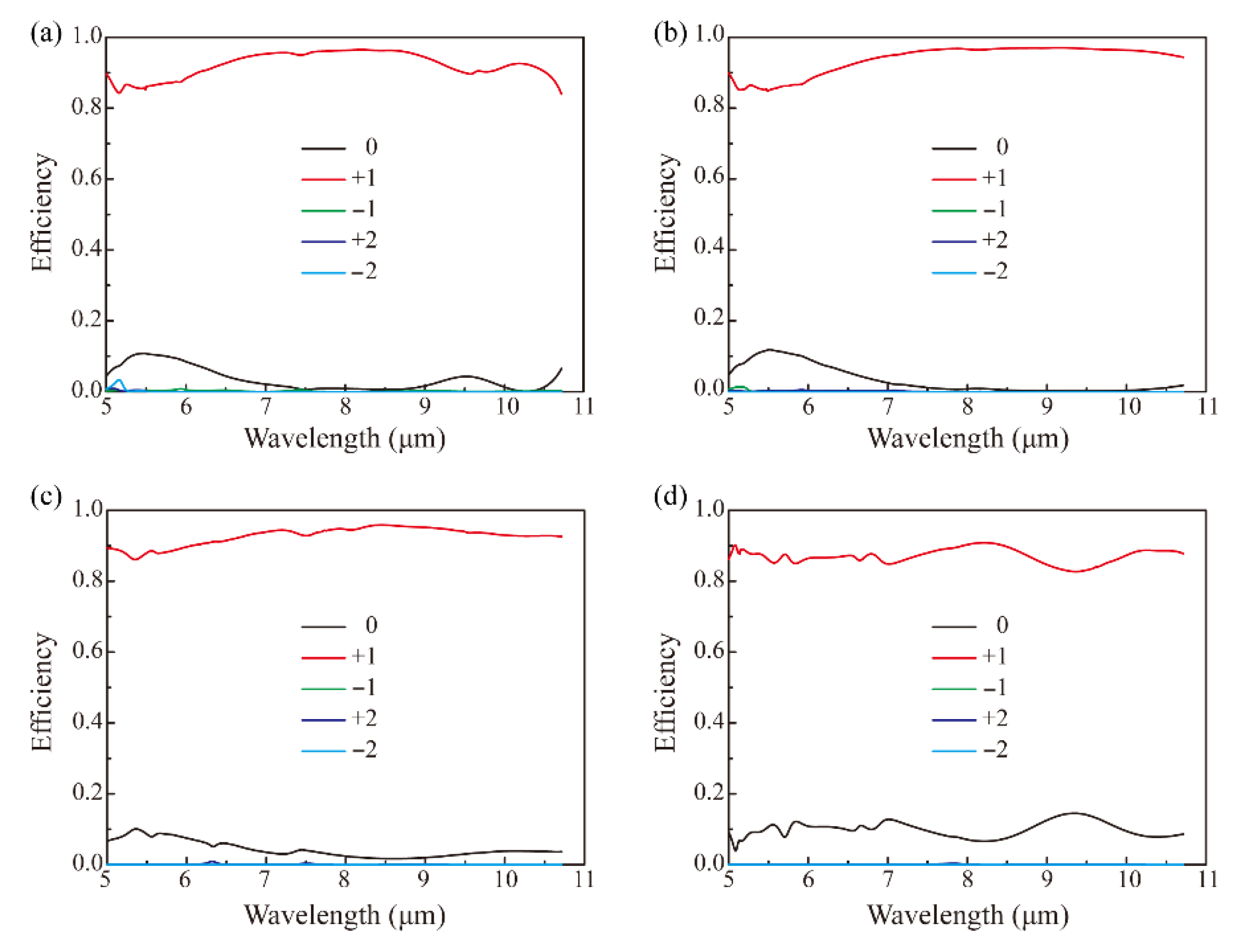Dielectric Catenary Metasurface for Broadband and High-Efficiency Anomalous Reflection
Abstract
1. Introduction
2. Theory and Methods
3. Results and Discussion
4. Conclusions
Author Contributions
Funding
Data Availability Statement
Conflicts of Interest
References
- Ding, F.; Pors, A.; Bozhevolnyi, S.I. Gradient metasurfaces: A review of fundamentals and applications. Rep. Prog. Phys. Phys. 2018, 81, 026401. [Google Scholar] [CrossRef] [PubMed]
- Hsiao, H.-H.; Chu, C.H.; Tsai, D.P. Fundamentals and Applications of Metasurfaces. Small Methods 2017, 1, 1600064. [Google Scholar] [CrossRef]
- Li, A.; Singh, S.; Sievenpiper, D. Metasurfaces and their applications. Nanophotonics 2018, 7, 989–1011. [Google Scholar] [CrossRef]
- Su, V.-C.; Chu, C.H.; Sun, G.; Tsai, D.P. Advances in optical metasurfaces: Fabrication and applications [Invited]. Opt. Express 2018, 26, 13148–13182. [Google Scholar] [CrossRef]
- Huo, S.; Wang, Z.; Shao, X.; Fu, Y.; Gao, M.; Ma, J.; Zhang, X.; Hu, Y.; Zhang, H.; He, X.; et al. Terahertz switchable vortex beam generator based on vanadium dioxide reflective metasurface. Opt. Commun. 2025, 574, 131206. [Google Scholar] [CrossRef]
- Song, M.; Feng, L.; Huo, P.; Liu, M.; Huang, C.; Yan, F.; Lu Y-q Xu, T. Versatile full-colour nanopainting enabled by a pixelated plasmonic metasurface. Nat. Nanotechnol. 2023, 18, 71–78. [Google Scholar] [CrossRef]
- Song, M.; Wang, D.; Peana, S.; Choudhury, S.; Nyga, P.; Kudyshev, Z.A.; Yu, H.; Boltasseva, A.; Shalaev, V.M.; Kildishev, A.V. Colors with plasmonic nanostructures: A full-spectrum review. Appl. Phys. Rev. 2019, 6, 041308. [Google Scholar] [CrossRef]
- Jiang, L.; Li, Y.; Yang, H.; Liang, S.; Zheng, L.; Qin, Z.; Zhu, Z.; Chen, H.; Wang, J.; Qu, S. Full-polarization-locked vortex beam generator with time-varying characteristics. Nanophotonics 2024, 13, 499–508. [Google Scholar] [CrossRef]
- Chen, D.; Yang, J.; He, X.; Yu, Y.; Zhang, Z.; Chen, H.; Zhang, Z.; Tan, Z.; Luo, H. Tunable Polarization-Preserving Vortex Beam Generator Based on Diagonal Cross-Shaped Graphene Structures at Terahertz Frequency. Adv. Opt. Mater. 2023, 11, 2300182. [Google Scholar] [CrossRef]
- Tang, P.; Si, L.; Dong, L.; Wu, G.; Ma, T.; Bao, X.; Sun, H. Tunable broadband terahertz graphene metasurface for complex-amplitude vortex beam generator and hologram. Opt. Laser Technol. 2024, 175, 110874. [Google Scholar] [CrossRef]
- Liu, Y.; Wang, B.; Hu, L.; Ji, X.; Zhu, T.; Pan, R.; Yang, H.; Gu, C.; Li, J. Ultraviolet Metalens Based on Nonlinear Wavefront Manipulation of Lithium Niobate Metasurfaces. ACS Photonics 2025, 12, 1857–1864. [Google Scholar] [CrossRef]
- Yang, M.; Shen, X.; Li, Z.; Wen, Z.; Chen, G.; Zhang, Z.; Liang, G.; Li, H.; Shang, Z. High focusing efficiency metalens with large numerical aperture at terahertz frequency. Opt. Lett. 2023, 48, 4677–4680. [Google Scholar] [CrossRef] [PubMed]
- Liu, Y.; Lin, J.; Lin, Y.-S. Reconfigurable metalens with dual-linear-focus phase distribution. Opt. Laser Technol. 2023, 164, 109526. [Google Scholar] [CrossRef]
- Hongli, Y.; Zhaofeng, C.; Xiaotong, L. Broadband achromatic and wide field of view metalens-doublet by inverse design. Opt. Express 2024, 32, 15315–15325. [Google Scholar] [CrossRef] [PubMed]
- Biabanifard, M.; Plaskocinski, T.; Xiao, J.; Di Falco, A. ZrO2 Holographic Metasurfaces for Efficient Optical Trapping in The Visible Range. Adv. Opt. Mater. 2024, 12, 2400248. [Google Scholar] [CrossRef]
- Li, Z.; Zhang, Y.; Yuan, J.; Hong, Y.; Liu, H.; Guo, J.; Dai, Q.; Wei, Z. Three-Channel Metasurfaces for Multi-Wavelength Holography and Nanoprinting. Nanomaterials 2023, 13, 183. [Google Scholar] [CrossRef]
- Zhang, F.; Wang, C.; Feng, W.; Liu, T.; Wang, Z.; Wang, Y.; Wang, M.; Xu, H.-X. Holographic communication using programmable coding metasurface. Nanophotonics 2024, 13, 1509–1519. [Google Scholar] [CrossRef]
- Wen, X.; Hu, Z.; Wang, H.; Chen, Y.; Ma, Q.; Li, G. Quasicrystal metasurface for optical holography and diffraction. Light Sci. Appl. 2024, 13, 246. [Google Scholar] [CrossRef]
- Li, Y.; Wan, S.; Zhao, R.; Zhu, Z.; Li, W.; Guan, C.; Yang, J.; Bogdanov, A.; Belov, P.; Shi, J. Huygens’ metasurface: From anomalous refraction to reflection. Opt. Commun. 2024, 565, 130648. [Google Scholar] [CrossRef]
- Li, Z.; Huang, L.; Lu, K.; Sun, Y.; Min, L. Continuous metasurface for high-performance anomalous reflection. Appl. Phys. Express 2014, 7, 112001. [Google Scholar] [CrossRef]
- Li, Z.; Palacios, E.; Butun, S.; Aydin, K. Visible-Frequency Metasurfaces for Broadband Anomalous Reflection and High-Efficiency Spectrum Splitting. Nano Lett. 2015, 15, 1615–1621. [Google Scholar] [CrossRef] [PubMed]
- Dong, G.; Jiang, Z.; Li, Y.; Zhu, Z.; Lv, T.; Sun, M.; Lv, B.; Li, Y.; Guan, C.; Liu, Z.; et al. Large asymmetric anomalous reflection in bilayer gradient metasurfaces. Opt. Express 2021, 29, 16769–16780. [Google Scholar] [CrossRef] [PubMed]
- Alrasheed, S.; Fabrizio, E.D. Design and simulation of reflect-array metasurfaces in the visible regime. Appl. Opt. 2017, 56, 3213–3218. [Google Scholar] [CrossRef] [PubMed]
- Maguid, E.; Yulevich, I.; Yannai, M.; Kleiner, V.; LBrongersma, M.; Hasman, E. Multifunctional interleaved geometric-phase dielectric metasurfaces. Light Sci. Appl. 2017, 6, e17027. [Google Scholar] [CrossRef]
- Liu, B.; Sain, B.; Reineke, B.; Zhao, R.; Meier, C.; Huang, L.; Jiang, Y.; Zentgraf, T. Nonlinear Wavefront Control by Geometric-Phase Dielectric Metasurfaces: Influence of Mode Field and Rotational Symmetry. Adv. Opt. Mater. 2020, 8, 1902050. [Google Scholar] [CrossRef]
- Zhi, J.; Guo, Y.; Hu, B.; Wang, X.; Yu, X.; Qiu, Z.; Huang, K.; Yao, M.; Xu, B. Generation of polarization rotation function Bessel beams based on all-dielectric metasurfaces. Opt. Commun. 2024, 550, 130014. [Google Scholar] [CrossRef]
- Kalwe, J.K.; Liu, X.; Li, J.; Zhang, Y.; Dirbeba, G.; Khan, K. Enhanced chiroptical effects and high-efficiency polarization-selective focusing based on dielectrically chiral metasurfaces. Opt. Commun. 2025, 577, 131334. [Google Scholar] [CrossRef]
- Deng, Q.; Yang, J.; Lan, X.; Zhang, W.; Cui, H.; Xie, Z.; Li, L.; Huang, Y. Investigations of generalized Pancharatnam-Berry phase in all-dielectric metasurfaces. Results Phys. 2023, 51, 106730. [Google Scholar] [CrossRef]
- Guo, Y.; Huang, Y.; Li, X.; Pu, M.; Gao, P.; Jin, J.; Ma, X.; Luo, X. Polarization-Controlled Broadband Accelerating Beams Generation by Single Catenary-Shaped Metasurface. Adv. Opt. Mater. 2019, 7, 1900503. [Google Scholar] [CrossRef]
- Pu, M.; Li, X.; Ma, X.; Wang, Y.; Zhao, Z.; Wang, C.; Hu, C.; Gao, P.; Huang, C.; Ren, H.; et al. Catenary optics for achromatic generation of perfect optical angular momentum. Sci. Adv. 2015, 1, e1500396. [Google Scholar] [CrossRef]
- Luo, X.; Zhang, F.; Pu, M.; Xu, M. Catenary optics: A perspective of applications and challenges. J. Phys. Condens. Matter 2022, 34, 381501. [Google Scholar] [CrossRef] [PubMed]
- Zhang, M.; Wu, Y.; Dong, P.; Wang, B.; Yang, L.; Shang, Y. High-efficiency terahertz wavefront manipulation based on optimized catenary metasurface. Opt. Commun. 2024, 559, 130364. [Google Scholar] [CrossRef]
- Chen, S.; Ha, Y.; Zhang, F.; Pu, M.; Bao, H.; Xu, M.; Guo, Y.; Shen, Y.; Ma, X.; Li, X.; et al. Towards the performance limit of catenary meta-optics via field-driven optimization. Opto-Electron. Adv. 2024, 7, 230145. [Google Scholar] [CrossRef]
- Xie, X.; Pu, M.; Liu, K.; Ma, X.; Li, X.; Yang, J.; Luo, X. High-Efficiency and Tunable Circular-Polarization Beam Splitting with a Liquid-Filled All-Metallic Catenary Meta-Mirror. Adv. Mater. Technol. 2019, 4, 1900334. [Google Scholar] [CrossRef]
- Chen, L.; Shao, Z.; Liu, J.; Tang, D. Reflective Quasi-Continuous Metasurface with Continuous Phase Control for Light Focusing. Materials 2021, 14, 2147. [Google Scholar] [CrossRef]
- Devlin, R.C.; Khorasaninejad, M.; Chen, W.T.; Oh, J.; Capasso, F. Broadband high-efficiency dielectric metasurfaces for the visible spectrum. Proc. Natl. Acad. Sci. USA 2016, 113, 10473–10478. [Google Scholar] [CrossRef]
- Shalaev, M.I.; Sun, J.; Tsukernik, A.; Pandey, A.; Nikolskiy, K.; Litchinitser, N.M. High-Efficiency All-Dielectric Metasurfaces for Ultracompact Beam Manipulation in Transmission Mode. Nano Lett. 2015, 15, 6261–6266. [Google Scholar] [CrossRef]
- Zhou, Z.; Li, J.; Su, R.; Yao, B.; Fang, H.; Li, K.; Zhou, L.; Liu, J.; Stellinga, D.; Reardon, C.P.; et al. Efficient Silicon Metasurfaces for Visible Light. ACS Photonics 2017, 4, 544–551. [Google Scholar] [CrossRef]
- Gong, J.; Xiong, L.; Pu, M.; Li, X.; Ma, X.; Luo, X. Visible Meta-Displays for Anti-Counterfeiting with Printable Dielectric Metasurfaces. Adv. Sci. 2024, 11, 2308687. [Google Scholar] [CrossRef]
- Peters, L.; Rocco, D.; Olivieri, L.; Arregui Leon, U.; Cecconi, V.; Carletti, L.; Gigli, C.; Della Valle, G.; Cutrona, A.; Totero Gongora, J.S.; et al. Resonant Fully Dielectric Metasurfaces for Ultrafast Terahertz Pulse Generation. Adv. Opt. Mater. 2024, 12, 2303148. [Google Scholar] [CrossRef]
- Gao, H.; Wang, Y.; Fan, X.; Jiao, B.; Li, T.; Shang, C.; Zeng, C.; Deng, L.; Xiong, W.; Xia, J.; et al. Dynamic 3D meta-holography in visible range with large frame number and high frame rate. Sci. Adv. 2020, 6, eaba8595. [Google Scholar] [CrossRef] [PubMed]
- Gao, H.; Fan, X.; Wang, Y.; Liu, Y.; Wang, X.; Xu, K.; Deng, L.; Zeng, C.; Li, T.; Xia, J.; et al. Multi-foci metalens for spectra and polarization ellipticity recognition and reconstruction. Opto-Electron. Sci. 2023, 2, 220026. [Google Scholar] [CrossRef]
- Palik, E.D. Handbook of Optical Constants of Solids; Academic Press: Cambridge, MA, USA, 1998. [Google Scholar]




Disclaimer/Publisher’s Note: The statements, opinions and data contained in all publications are solely those of the individual author(s) and contributor(s) and not of MDPI and/or the editor(s). MDPI and/or the editor(s) disclaim responsibility for any injury to people or property resulting from any ideas, methods, instructions or products referred to in the content. |
© 2025 by the authors. Licensee MDPI, Basel, Switzerland. This article is an open access article distributed under the terms and conditions of the Creative Commons Attribution (CC BY) license (https://creativecommons.org/licenses/by/4.0/).
Share and Cite
Lu, X.; Li, W.; Chen, G.; Liu, B.; Xie, X.; Zang, Z.; Hai, K.; Li, Z. Dielectric Catenary Metasurface for Broadband and High-Efficiency Anomalous Reflection. Photonics 2025, 12, 684. https://doi.org/10.3390/photonics12070684
Lu X, Li W, Chen G, Liu B, Xie X, Zang Z, Hai K, Li Z. Dielectric Catenary Metasurface for Broadband and High-Efficiency Anomalous Reflection. Photonics. 2025; 12(7):684. https://doi.org/10.3390/photonics12070684
Chicago/Turabian StyleLu, Xinjian, Wenxin Li, Guiyong Chen, Bo Liu, Xin Xie, Zhongming Zang, Kuo Hai, and Zhu Li. 2025. "Dielectric Catenary Metasurface for Broadband and High-Efficiency Anomalous Reflection" Photonics 12, no. 7: 684. https://doi.org/10.3390/photonics12070684
APA StyleLu, X., Li, W., Chen, G., Liu, B., Xie, X., Zang, Z., Hai, K., & Li, Z. (2025). Dielectric Catenary Metasurface for Broadband and High-Efficiency Anomalous Reflection. Photonics, 12(7), 684. https://doi.org/10.3390/photonics12070684





